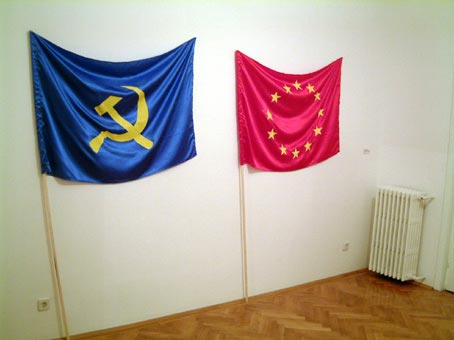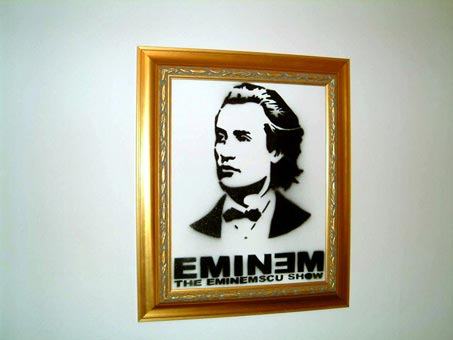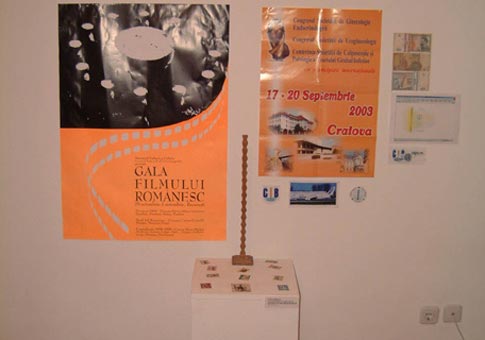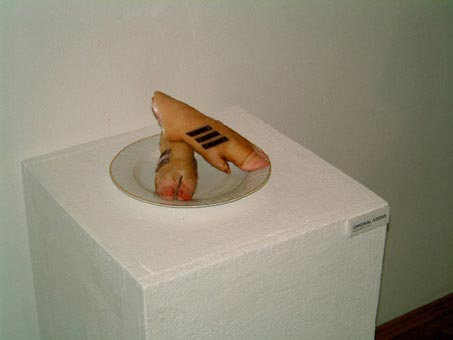VLAD NANCA lives and works in Romania
2020 Home Gallery - 7 November 2003
The works presented here in the apartment-show Vlad Nanca lives and works in Romania display a shift in approach in Nanca's production. As its title explains, the group of studies brought together in the artist's flat sets out to underscore his position within the social texture of Bucharest and Romania. Although one of his previous works, his installation entitled Swing Me [2001] had a pronounced reference to the effects of the drastic shift in the recent history of Romania on its citizens' daily life, his other works, mainly photographs have studied the various trivial occurrences of the urban experience that remain irreducible to a geo-cultural specificity -such as urban furniture, dull surfaces of public transportation, construction equipment left on the street, graffiti, etc. This time, in Lives and works in Romania Nanca studies directly a series of objects, icons and tropes that have constituted the Romanian national identity (or its crises), ruses and slang of the Romanian language that mark the social impasses of the country.
Nanca's photographs of Dacia cars loop on a computer screen. The circularity in their presentation parallels to the production of the car in Romania for a twenty five year period without a major change in its design. The very minute alteration on the original Renault 12 design produced a quality of locality and to veil the fact that the know-how was in fact imported this car was baptised with a name that refers to the soil of Romanian essence, an ancient root imaginatively employed for claiming the continuity of national spirit. Not being courageous enough to vision a future to come, but mistakenly fall back to the prisons of a past, this car started to illustrate allegorically the mental and economic stasis of a whole country (and ideology). Far from small but gradual subversions of a peripheral culture that takes the discourse of the central culture and displaces it playfully -as affirmed in Homi Bhabha's theoretical work-, the Dacia came to symbolise ossification and establishment of poverty. Nanca's use of them is perhaps an elegiac farewell to one of the objects that defined his urbanscape from his birth on, but also a progressive attempt to seal off the past.
The small stencil detournement that plays on the phonetic similarity between the names of Romania's national poet Eminescu and contemporary hip-hop star Eminem illustrates the current confusion in the country which is squeezed between the introversion of a societal collectivity typical to periods of crises and the showering of globally rotating signifiers of spectacle, in which the icons of the different ideological constellations bleed into each other. The documentary-based piece of the exhibition that brings together Nanca's collection of objects that bear the image of the famous modern sculptor of Brancusi and his artworks gives a wider scope of how the status of an artist was employed differently for changing ideological purposes. First ignored by the state-communism as the symbol of decadence of bourgeois aestheticism, he became after his death one of the tools of promoting the country's image to other cultures. These days the iconography around him is being recklessly plundered by the image- and icon-thirsty circulation of Capital for the most unrelated and absurd purposes.
The dizzying shift between the two, once warring ideological semi-continents, the state-communism of Eastern Europe and liberal social democracy of Western Europe is taken up by two flags referring them. One of them bares the sickle & hammer combination used by USSR and some of its satellite states, the other bares the circular twelve stars of the EU. Will the latter truly replace the former? Is the EU really the only alternative that is available for Romania still trying to heal the traumas of its nightmarish past? Nanca's sardonic swap between the colours of the two flags points at that confusion but perhaps he is also construing an utopian alternative to prescription marketed as the single solution: a collective rethinking of commun-ism from scratch. The same tension between the two ideologies are used in two further pieces. The first one is concerning the difficulty in finding and buying meat in the Ceausescu-era. The complementary parts of the animals that are bought instead were named by the general population after luxurious goods to be found in the West. Thus, the flimsy claws of chicken were called ‘cutlery’, the pork head ‘computer’ and the meatless feet of the pork ‘adidas’. The latter ironic metaphor is literalised by Nanca through the three stripes of the famous brand placed onto a pork feet. Another piece, ‘the winning lottery’ tells the more recent past: an actual lottery ticket sold in the streets of Bucharest that guarantees the winning of a prize -yet with a trick, the fixed prize remains always much lower than the money you pay for that ticket. A brief summary, you would say, on the mechanism of capitalism: a constant promise of profit but the seizure of a higher input in an abstracted route.
The other two projects included in the Lives and works in Romania do not contemplate inductively on the unique, in-dividual, homogenous idea of a nation, but they mark its splintering into singular pieces –just as in Nanca’s previous photographs with their emphasis on the everyday life. The post-it’s stuck onto the wall near Nanca’s telephone give numbers of people with funny sounding names found in directories. The Romanian language is, for sure, the source of the communicability of these joke-like names, but also the contingencies that produced these amalgamations of names and surnames, are the leading factors behind their grotesque character. Similarly, the photographs taken from streets of Bucharest diverge from the representative mode and overdetermined cultural specificity. The peculiar occurrences on the streets to be found in these pictures are offered by Nanca as proposals for installations and sculptures, underlining the aesthetic ready-made richness of the urban texture.
Erden Kosova
List of works
I DO NOT KNOW
WHAT UNION I WANT TO
BELONG TO ANY MORE
MIXED MEDIA, 2003
EMINEMSCU
AEROSOL ON CANVAS, 2003
VLAD NANCA
COLLECTION OF BRANCUSI
ARTIFACTS AND MERORABILIA
MIXED MEDIA, 2003
READYMADES / SKETCHES
FOR INSTALLATIONS
PHOTOGRAPHY, 2003
DACIA - 25 YEARS
OF SOCIAL HISTORY
DIGITAL IMAGE SLIDE SHOW, 2003
CALL ME
POST IT NOTES, 2003
ORIGINAL ADIDAS
MIXED MEDIA, 2003
WINNING LOTERY TICKET
READYMADE PRINTED PAPER, 2003
 I DO NOT KNOW WHAT UNION I WANT TO BELONG TO ANY MORE MIXED MEDIA, 2003 |
 EMINEMSCU AEROSOL ON CANVAS, 2003 |
 VLAD NANCA COLLECTION OF BRANCUSI ARTIFACTS AND MERORABILIA MIXED MEDIA, 2003 |
 ORIGINAL ADIDAS MIXED MEDIA, 2003 |